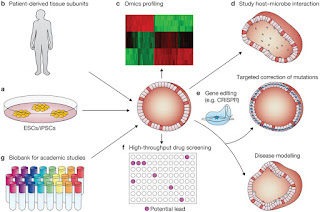It takes multi million dollars to develop a new drug as an
estimated 1 out of 10,000 chemicals that enter the discovery cycle (Figure 1)
ever reaches the market. The rising percentage of late-stage clinical failures
(50% in phase 3) is also alarming. The imperative reason for such low success is
our inability to represent human tissue in laboratory. Test models like flat
surface cell-culture, virtual computational methods and small animals cannot
replicate human system; as a consequence the outcome has not been clinically
valuable most of the time. Cells accustomed to spatially dynamicmicroenvironment are conventionally studied in isolation; mostly as homogeneous
cultures must not be expected to display bona-fide behavior. Engagement of
cells with immediate extracellular matrix (ECM) and neighboring cells has been
overlooked while evaluating their response to peripheral stimulus; be it in the
form of drug or toxin or intrinsic physiological entities like enzymes and
hormones. Nevertheless, lack of appropriate ECM milieu has impacted least on in
vitro studies related to intracellular molecular-machinery saving us from
getting fundamentally wrong.
Non-availability of a flexible 3D system is attributed to be
the major obstacle in establishing new standards through organotypic cell
culture [3]. Nevertheless, commercial availability of scaffolds like
Ultra-Web®, Extracell®, ECM-analog®, BD-Matrigel®, Corning-Matrigel®, Alvetex®,
BioVaSc®, Algimatrix® and spheroids of 3D-Biotek® that allow organotypic
culture and especially the ones available in conventional plate formats are
expected to change the scene.
A dynamic and reciprocal exchange of information between
cells and ECM contributes significantly in tissue specific gene expression
regulating its morphology and physiology. The hierarchy of ECMmediated
signaling in tissue differentiation and physiology is elegantly demonstrated by
Bissell et althrough ex vivo modeling of milk secreting mammary glands using
Matrigel a tumor derived ECM. We need an efficient cell-interactive scaffold of
benign origin, having good shelf-life and stability, for studying cell-ECM
dynamics in an experimental micro-environment. Adapting organotype culture
could reveal true behavior of cells in real tissue like layout and also
elaborate on contextual cell-cell and cell-ECM dynamic relation. Cell- ECM
dynamics being at the helm of fundamental understanding of normal vs.
abnormal-cell response could thus provide an altogether new meaning to our
approach towards therapeutics. Improved comprehension of bi-directional
relation of cell with its surrounding milieu has a potential to create a new
line of drug design focused on empowering and restoring the natural
microenvironment to revert the unhealthy or diseased condition.

No comments:
Post a Comment